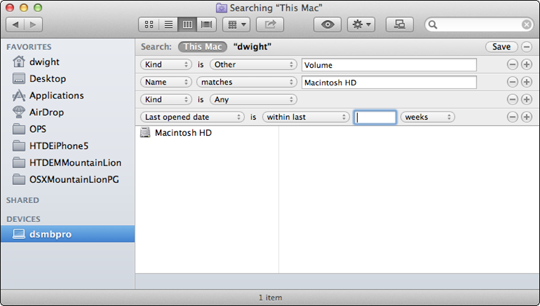Searching for Items
Apple introduced Spotlight in Mac OS X Tiger and instantly changed the way Mac users look for items on their computers. Spotlight finds things on your Mac much faster than you could if you were poking around every file and folder. In fact, it’s the quickest way I’ve ever seen to find things on a computer.
When you first log in to your Mac, OS X creates an index of every file and folder it contains. Mountain Lion knows everything there is to know about every single thing that occupies your Mac, whether the item is visible or not. Mountain Lion stores this information, or metadata, and Spotlight uses the information, along with filenames and content, to find what you are looking for. Every time you add or remove an item, or add or remove something within that item (like text within a document), Mountain Lion updates its index files, thereby keeping all your searches up-to-the-minute accurate.
You might think that with all this information to look through a search could take forever, but that’s not the case at all. Spotlight can find items containing your search words almost as quickly as you can type them.
Searching with Spotlight
Chances are good that no matter how long it’s been since you’ve seen the file you’re looking for, Spotlight can dig it up for you. Let’s see how to use this amazing feature:
1. Click the Spotlight icon (the magnifying glass) in the upper-right corner of the Mac window to reveal the Search text field, as shown in Figure 1.11.
![]()
1.11 Type your search words into Spotlight.
2. Type your search criteria in the text field. Some applications have Spotlight Search fields in their toolbars, which you can use to type search words when specifically searching for items within that application (for example, when searching for an e-mail within Mail).
3. Spotlight immediately begins searching your Mac and displays the information it finds that matches the criteria you typed in Step 2.
4. Scan the list for the item you want and then click it to open it in its default application. Spotlight only shows the top matches in each category. To see all the matches, click Show All at the top of the list.

Did you notice that Spotlight doesn’t only show you items such as documents and folders that contain your search words? Spotlight literally searches every file on your Mac for your search criteria, including e-mails, web pages you’ve visited, contacts, music, movies, images, and PDF files. Spotlight can even search other Macs on your network if they have file sharing enabled.
You can easily modify Spotlight to search where and how you want it to, using its preferences. Choose Apple menu→System Preferences, and then click the Spotlight icon in the Personal section to access the Spotlight preferences pane, as shown in Figure 1.12.

1.12 The Spotlight preferences let you search the way you want.
Figure 1.12 shows the Search Results section of the preferences pane. This section lists the categories of files that appear in the search results window. Select the check box next to those categories you want Spotlight to search and deselect those you want it to leave alone.
For example, if you don’t want Spotlight to check your e-mail when performing a search, simply deselect the Messages & Chats check box. You can also click and drag the categories into the order in which you prefer the results to be displayed.
Click the Privacy tab at the top of the preferences pane to reveal the Privacy list. This section allows you to specify directories (folders) on your Mac that you want to exclude from any searches.
To modify the Privacy list, follow these steps:
1. Click the plus sign (+) under the bottom-left corner of the list.
2. Browse your Mac for the folder you want to exclude from searches, highlight it, and then click Choose. The folder is now shown in the Privacy list.
3. You can remove a folder from the list by highlighting it and then clicking the minus sign (–) under the bottom-left corner of the list.
The two check boxes at the bottom of the preferences pane allow you to enable Spotlight keyboard shortcuts for opening a Spotlight menu or window with the stroke of a couple of keys, as shown in Table 1.6. You can also select which keys perform these functions by choosing a key combination from the pop-up menus next to each option.

Searching with the Spotlight menu is certainly fast and easy, but it doesn’t always yield the best results. In fact, it may give you so many results that you could never realistically review them all in a reasonable amount of time. To remedy this situation, Spotlight brings in your trusty friend, the Finder.
Searching within a Finder window
The Finder gives you much more leverage to enhance your search beyond the Spotlight menu’s capabilities.
To perform a basic Spotlight search within a Finder window, follow these steps:
1. Open a Finder window by pressing ![]() +N while the Finder is activated. If the Finder isn’t the activated (or foremost) application, click the Finder icon on the left side of the Dock.
+N while the Finder is activated. If the Finder isn’t the activated (or foremost) application, click the Finder icon on the left side of the Dock.
2. Browse your Mac for the folder that includes the files you are looking for (or through), and click on it to highlight it.
3. Type the search criteria into the Search text field in the upper-right corner of the Finder window. Your results are displayed in the Finder.
Any search utility worth using allows a lot of flexibility to narrow searches, and Spotlight is as flexible as they come.
Figure 1.13 shows a Finder search window that has been assigned several search attributes to act as filters for your search results. These attributes allow you to specify the type of file you want, including its name, when it was last opened, and many other specifications.

1.13 Customize your searches in Spotlight.
To add attributes to a search, follow these steps:
1. Click the plus sign (+) next to Save in the upper-right area of the Finder window to add the first attribute.
2. Choose the type of attribute to use by clicking the pop-up menu, as shown in Figure 1.13. There are many more attributes preconfigured by Apple that you can access by choosing Other from the attribute list. You can also add other conditions (specifically, the All, Any, or None of the following are true criteria) to the search by holding down the Option key while clicking the plus sign (+). Also, some attributes have several pop-up menus that you can change to customize them.
3. Make any setting changes to the attribute to narrow your search.
4. Your new filtered search results are displayed almost instantly after you add an attribute.
5. Continue to add or remove (by clicking the minus sign) as many attributes as necessary.

Use Boolean operators such as AND, OR, and NOT to logically narrow your search. You may also use quotes around text to specify that the words in the quotes must be found in exactly the order you typed them.
